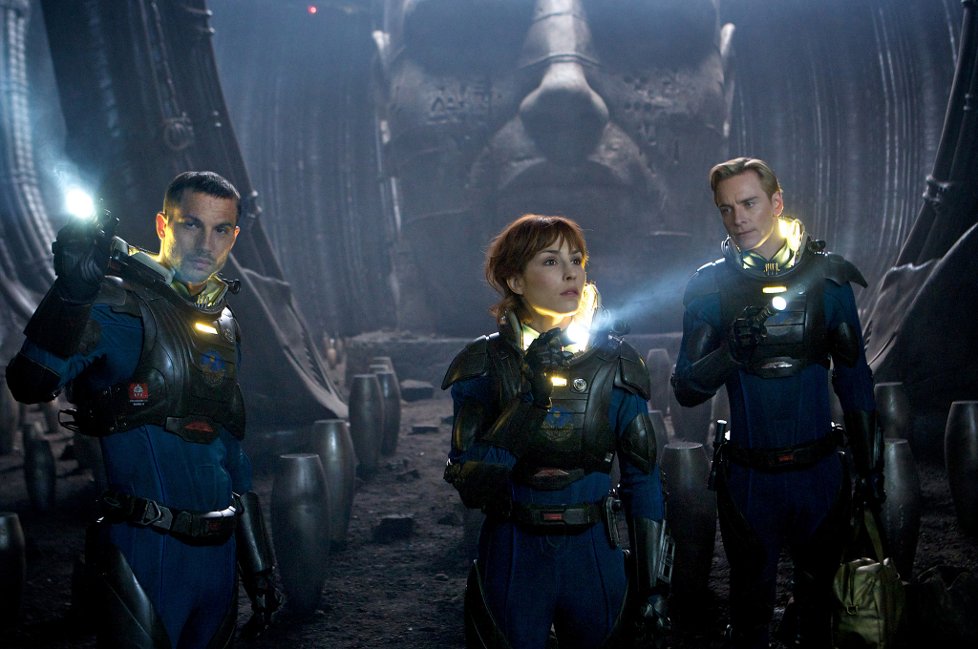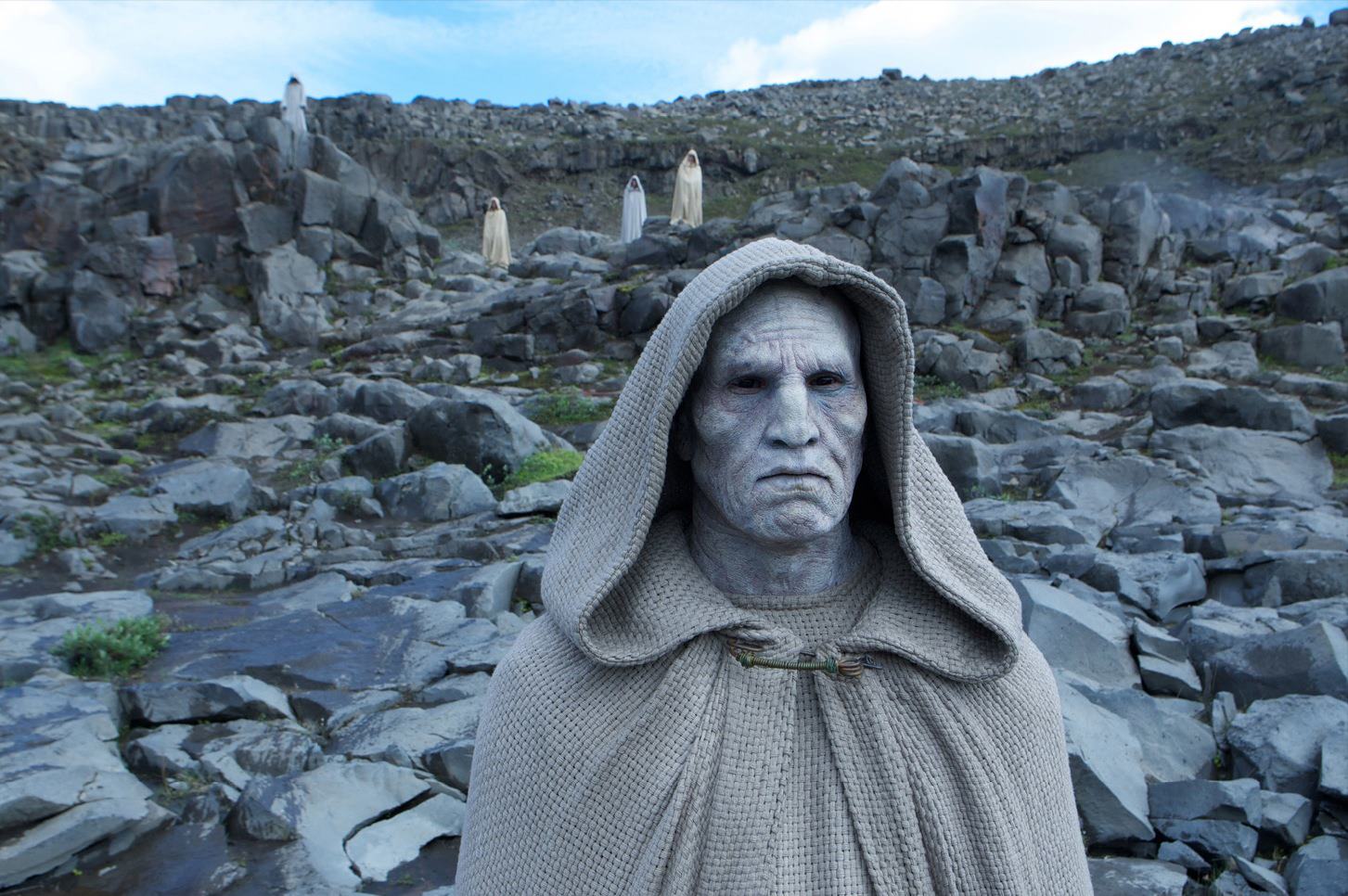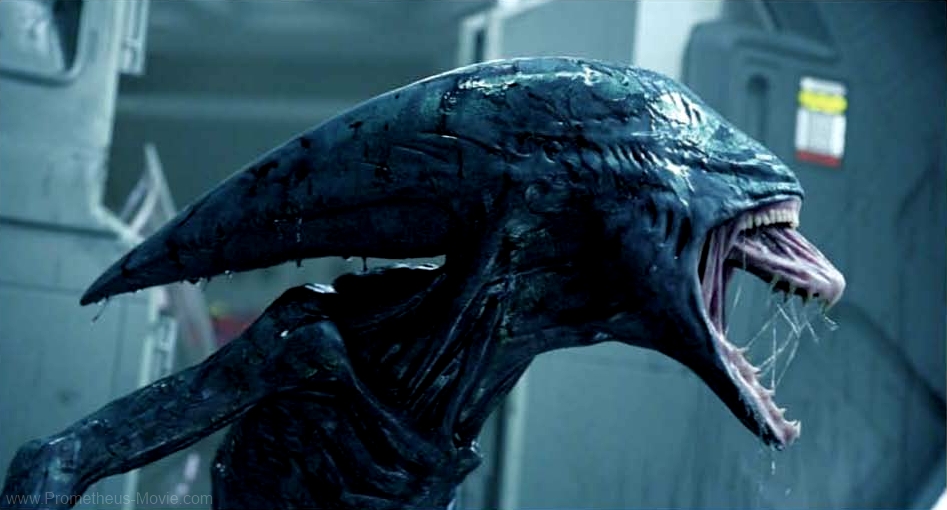One of the movies I looked forward to the most in 2012 was Ridley Scott‘s Prometheus. Now the John Spaihts draft of the screenplay has leaked, which gives us an opportunity to examine what Scott and second screenwriter Damon Lindelof tweaked and changed for the finished film.
My writing partner, Pål, said something about the coming of Prometheus that stuck in my mind. If it rules, we’ve got a sci-fi classic on our hands. If it doesn’t, we’ve got something to talk about for years. How prophetic!
(Continues under the picture…)
To me, some of the film was enjoyable, and some of it downright annoying. Let me be clear, I loved the premise, I loved Scott’s visuals, and I loved the character of David (the ever superb Michael Fassbender). But I detested the clichéd and unbelievable cast of characters that made up the crew, the absence of logical motivations for them, as well as the monster-orama that plagued the story from about the midway point.
For all of Scott’s talk about not really making an Alien prequel, that final shot of the very recognizable Giger monster was a fanboy sell-out of embarrassing proportions.
So, is Spaihts’ script much different? It’s very much the blueprint of the story as it was told in the film, but on several key issues it differs from the end product. I’ll highlight some of these here, but I recommend anyone interested to read the script, which you can find here.
EDIT: You can not find it there, not anymore, probably because Fox’s lawyers stay up all night hoping that they’ll get an even better paid job. Since I personally don’t give a shit, and I’m pretty sure Fox’s lawyers don’t give a shit about me, here it is: Alien: Engineers. Spaihts has confirmed that this script is the real deal, and not a fake. He didn’t seem to have a problem with people reading it either, and it’s valuable for aspiring screenwriters who hope to help Fox and other studios make even more money in the future.
So, enough with the bullshit, let’s get on with it!
CHARACTERS
The protagonist is known here as Doctor Jocelyn Watts, and she is a scientist 32 years of age. Her partner, and love interest, is the significantly older Professor Martin Holloway. The dynamic between the two is very different from the relationship between Elizabeth Shaw (Noomi Rapace‘s character) and Charlie Holloway (Logan Marshall-Green), of same age, that is portrayed in the film.
The most immediate effect of this is the more intimidating status of Professor Holloway as a weather-beaten field researcher, a more interesting mind than the film’s younger Holloway. There is also a different, and less standard, tone to the love story subplot. It’s still a love story (which I think Alien movies can largely do without), but it’s more uneasy and less clichéd because of the difference in age.
(Continues under the picture…)

L-r: Charlie and Elizabeth, the lovers/scientists, with android David, the film’s most interesting character by a mile.
The general difference between Spaihts’ cast of characers and that seen in the finished film is indeed age. Spaihts’ script ensemble is older, and thus they carry a little more weight in the proceedings than most of Scott’s on-screen ensemble. Professor Holloway is a good example, but we can also include Captain Janek (the Idris Elba character in the film) as well as Weyland’s right hand lady, Vickers (portrayed by the icy Charlize Theron in the film). The latter in particular is significantly older in the Spaihts version of the story.
SETTING AND EXPOSITION
A major difference is found in the first 20 minutes of the story. The exposition and set-up is actually simpler and more believable than in the finished film. Watts and Holloway make a major discovery in the depths of the Mediterranean, persuasive proof of an ancient extraterrestrial presence on Earth. They then meet with billionaire Peter Weyland in person on a space station called Weyland’s Wheel, and agree on a deal for deep space exploration of the Zeta Two Reticuli solar system.
Weyland’s motivation is simple: Indications are that the extraterrestrials terraformed our planet to make life possible, they were engineers of life. This is what Weyland does, “building better worlds”… But his venture on Mars goes ill, and he is tempted by the possibility of securing the alien technology for terraforming. Thus he funds the expedition in return for sole rights to all technology that might be discovered.
Straight forward, really. And there is no need for a post-departure Basil Exposition scene via hologram. The briefing of the crew is actually done almost completely off-camera in this version. Weyland does not take secret part in the expedition either, which makes the Vickers character, Weyland’s reluctant lieutenant, more useful.
The crew is under Weyland orders, as Vickers says – “Classified job, triple pay”, with no percentage deal. So they have a believable motivation for being there (money), a believable reason for being somewhat resentful (no percentages), and they seem fairly good at their respective jobs, which makes it more believable that Weyland and Holloway would have picked them for the assignment in the first place.
Not Alien good, but not Prometheus bad either, on this issue.
(Continues under the picture…)

Peter Weyland (portrayed by Guy Pearce) in a scene that wasn’t in the actual film. Personally, I would have liked to see this version of the character interact with the scientists, not the decrepit loon we got.
Another major difference is the main setting of the story. In Spaihts’ script the expedition searches the Zeta Two Reticuli system for a likely planet or moon to investigate, and they settle for LV-426. That’s right, the proper Alien moon, that is. This setting gives the story a stronger sense of danger and foreboding. It might be re-treading old ground, but setting it on LV-something-else-entirely in the film only had the effect of making me think “what, we’re not gonna go there?”
Which we didn’t, but which we obviously will in the sequel.
Scott’s just postponing the inevitable.
PLOT AND MOTIFS
In essence, the Spaihts plot is the same as in the finished film. But there are probably two major areas where it differs. First, it has none of the overtly thematical science versus faith motifs that the film is pretty heavy on. It can certainly be read into it, but Watts (the Shaw substitute) does not carry a crucifix and does not have a crisis of faith during the story. Likewise, Weyland is not tagging along and does not have any “I want to live forever” moment as he’s encountering the Engineers. Weyland remains a background figure.
For my money, this is good. Those themes should be possible to read into a good sci-fi story of this sort anyway. When Prometheus makes the themes explicit, I get the sense that Scott and Lindelof either don’t believe in the audience’s powers of extrapolation, or that they are a little too desperate to differentiate the film from the original Alien.
The second point about the plot plays into this. Spaihts’ story has a weakness typical of all Alien films post-Aliens. It’s too damn similar when the heat is put on. The characters end up in a situation where a very recognizable monster hides in air shafts and knocks off people one by one. The third act of the script is pretty much Alien re-created, with familiar horror sequences and a familiar structure. So it’s easy to understand why Scott and Lindelof wanted to shift the focus to the Engineers in their final act.
(Continues under the picture…)
The good thing about Spaihts’ version is the lesser amount of Engineer violence towards the climax, and the lesser amount of monster-orama. In my opinion, Prometheus made fatal mistakes in the final act. The multiple versions of the alien monster turned into a kind of self-mocking parody, and the cruelty and malice of the Engineers made very little sense even as the story came to a close.
Scott talked up Prometheus as not really being an Alien prequel. Does anyone who saw the film take that seriously? The director wants you to believe that when Lindelof came onboard, the project shifted dramatically to become something else than an Alien prequel.
Quite how Prometheus is not directly connected to the mother-franchise is anyone’s guess, and quite frankly a ludicrous notion. There is no such great difference between the Spaihts script (conceived as a prequel) and the Lindelof/Scott version (hyped as something more than a prequel).
SO, WHAT’S NEW?
Spaihts’ script is tight, clocking in at 117 pages, and well-written. There are good lessons about writing simple and effective shots here. In sum, I’d say it flows better than the finished film does. So what did Lindelof bring to the table that made Scott more enthusiastic?
The title change and the shift towards overtly religious motifs is the most obvious difference. Rename the research vessel Magellan, call it the Prometheus and make that mythological motif central to the characters and story. This legend is mentioned in Spaihts’ story, but it’s not a major focus. This shift has consequences for two characters – the leading lady (Watts/Shaw), and Peter Weyland. The former gets a Crisis of Faith which is at odds with her scientific mind, while the latter goes on a kind of Grail Quest for eternal life. None of these things are strong points in the movie.
Lindelof and Scott also lower the average age of the cast. I don’t get the thinking behind that, since the only obvious effect it has is to also lower the believability of the characters.
The final major issue is the restructuring of the third act. I understand very well the desire to make it different from previous Alien movies, but I don’t understand why the recipe should be more monsters, more mutations, and more violent Engineers.
Sure, the spectacle is different from the previous movies, but the story becomes a mess which Scott only promises to sort out in the sequel.
A very good thing is that Michael Fassbender’s David looks sure to be important there.
Another good thing is the screenwriting and storytelling lessons to be learned from this project, whether you were thoroughly entertained or not.
EDIT: Damon Lindelof’s draft, titled Paradise, can be downloaded here.



Pål
One of my first thought when I read this script was: should a philosphical creation story be told within the Alien context at all? Maybe it’s a bad idea from the get go? Perhaps a story of humans cofronting their interstellar creators would stand a better chance on it’s own, instead of as a part of the Alien franchise?
When the two ingredients are mixed the result is confusing and messy. Which is a shame, because there’s a good movie in there somewhere.
Christer
I think you have a very good point there. It feels like Scott et al are a little worried about doing an old-fashioned Alien movie (they feel it has to be something more), and yet they are so tempted to stay in that universe.
Personally, I don’t think that philosophical creation stories can’t be told in this universe, but why be overt about it? Damn, if the first two Alien movies don’t have these issues working, I don’t know what. They’re just better because they let it be the background that no one will be able to figure out. Kubrick might have had something to say about that.